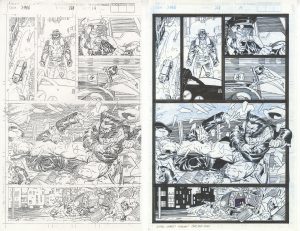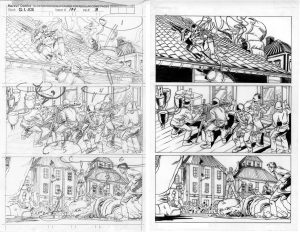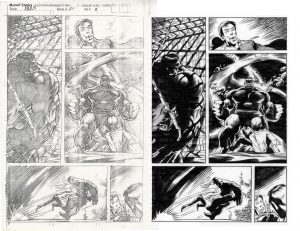I’ve been thinking a bit lately about the things that collect in our lives. Not the things we collect, like comic books, DVDs, stamps, Beanie Babies, or whatever else you got, but the things we take along with us without giving them a lot of thought. The things that build up in closets and junk drawers that are around us. They’re not always junk. Sometimes the stuff to be found in junk drawers are sign posts that mark certain places we’ve passed through on the way from there to here. As an artist I have a lot of stuff tucked away. Art that I made a long time ago. It’s not junk. I have no interest in throwing it out but some of it doesn’t exactly fit into the art category. Some of that stuff is what I’m contemplating today.
Way back in 1990 I was lucky enough to be working in the Marvel Comics production bullpen. That’s where all the behind the scenes stuff that needs to be done to get a comic book ready to be printed gets done. It wasn’t a great job but it was a great experience. It was a fun place filled with a lot of creative people and most of us loved comics. It was also a great place to learn about making comics. Editing, writing, pencilling, inking, lettering, and coloring. It all got done there and there was always someone willing to share how something was done.
That brings us to inking. Inking a comic book began because it’s much easier to print a comic from an ink line than from a pencil line. So after a comic book is drawn in pencil it’s inked. That means it’s redrawn in ink. It’s not quite as easy as that one sentence makes it sound because there is a lot of nuance to inking. Since the pencil drawing isn’t going to be reproduced it usually isn’t a finished drawing. To save time some subtleties of the drawing are left out. The inker will put that stuff in. So the final drawing is a collaboration between the penciller and the inker.
The main problem with learning to ink is finding pencils to ink over. When you’re a young artist it’s not easy to learn how to pencil and ink at the same time with your own work. A young artist inking over his or her not quite professional pencils can lead to a lot of frustration. You still have to do it but learning over professional pencils can help a lot if you can get copies of some. Thanks to the internet a young artist can find copies of professional pencils online with a few clicks. But back in 1990 there was almost no way to get them. So it was lucky for me that I was working at Marvel.
In those pre-digital days an inker worked right over the top of a penciller’s pencils. It was all done on one piece of paper so the original pencils were gone by the time the inker was finished. But the pencils were often photocopied first so that they could be lettered on an overly at the same time as they were being inked. We in the bullpen had access to lots of photocopies of pencils. Of course photocopy paper isn’t good enough quality to ink on so that the inks had to be done on an overlay.
An overlay is when you take one piece of paper and put it on top of another piece of paper. In this case I’d take a piece of vellum, a thick tracing paper, and tape it on top of a photocopy of pencils. Working on vellum isn’t ideal. Though it works fine for the task vellum isn’t perfectly clear, much like regular tracing paper isn’t, so you really have to concentrate and make sure of what you’re looking at. That and the vellum tends to curl up a little bit as ink is applied to it and dries. As a consequence the vellum doesn’t always want to sit flat on top of the photocopy. I used to combat this by holding the paper down with the handle of a brush in my left hand as I inked with a brush in my right hand. I made it work.
It took me a while to ink a page like this back in the early 1990s. It probably took me about six or seven hours a page. That was a long time to put into practice pages. I never dated them so I have no idea what years they span but I would bet from 1990-1992. I have about forty of these pages so that’s a good month’s worth of work. As I was also working on my own drawings and inking over my own drawings I’d do a few of these practice pages every now and again until I didn’t think the practice would do me any good anymore.
So now it’s twenty five years later and I still have these inks on vellum that I did. They’ve been sitting in a drawer all these years. I’m glad that I kept them because that means that I kept the photocopies of the pencils that went with them. They’re the real prize. I wish I had kept even more of the photocopies. After we were done with our work with them in the bullpen we just threw the photocopies out. We’d keep a special one every now and again but mostly they were trashed. Otherwise weed be flooded with them and no one had the room for that. Plus there would always be new photocopies of pencils the next day. We were young and thought it would go on forever that way. That’s the way of youth.
The photocopies I understand but I can’t quite figure out what my practice inks are now. Are they art? I don’t think so. They look like art since they look like comic book pages but they’re not the pages that were printed in the comic book that the pencils are from. They’re kind of nothing. I still like them and find them a little interesting because they’re mine but what are they to anyone else? Who knows? I’m still trying to figure out what if they’re more than a curiosity to me. I do like curiosities though.



Discussion ¬